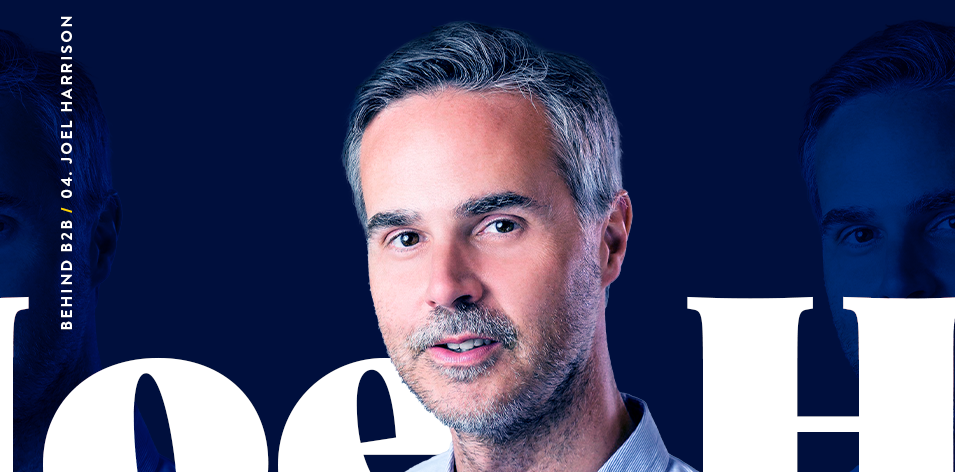

For the fourth instalment of Behind B2B, our series exploring the brightest minds in the industry, we meet Joel Harrison – founder and editor-in-chief of the globally acclaimed B2B Marketing.
If you’re a B2B marketer, chances are you’ve spent some time on B2Bmarketing.net – arguably the world’s best resource for B2B training, insight and inspiration. And if you have, you’re already familiar with Joel’s work – because he’s the founder and editor-in-chief, not to mention a public speaker, panelist, commentator and evangelist for all things B2B.
We sat down with Joel to pick his brains on how the industry has changed, where it’s going, and crucially – how he ended up writing about it in the first place.
I was a journalist and my business partner was a salesman (he denies that, but it’s true). We just kept having these conversations: if we could work for ourselves, what would we do?
Back in 2003, there were so many marketing publications – plenty of stuff on PR, sales and the like – but a real gap in the market for B2B. The more we thought about it, the more we realised: that’s our niche.
It was the right time of life to take a gamble. I was 30 – no kids, no mortgage, no marriage. Old enough to be taken seriously; young enough not to be paralysed at the thought of it going wrong. So we launched B2B Marketing and said: in three years, we’ll either be bust, or millionaires. Funnily enough, neither came true, but hey. This time next year, Rodney…
I love the geekery of B2B. It’s technical, you have to engage your brain. When I was working as a journalist back in the early noughties, mates used to say: when are you going to work for FHM or something? Suffice to say, I never had any interest in that particular sort of journalism. I’ve always loved exactly what we do with B2B Marketing: technical, interesting, challenging topics.
So yes – while I didn’t necessarily grow up dreaming of writing about B2B, I did always have ambitions of being a journalist. I was news editor of the student newspaper (Nottingham’s Impact magazine) at uni, and I loved the spirit of it – running around chasing stories, pulling it together, spending our weekends poring over it. It was a real buzz.
Anyway, I wound up taking a job for this newsletter company when I graduated. It ended up being a lot of fun – and I learnt a huge amount about tech. That was 1996, after all, so a real tipping point for the explosion of tech that followed. And then B2B Marketing happened.
I’d pinpoint a few inflection points. About 2007, Jon Miller of Marketo wrote that blog where he defined the term ‘modern marketing’. At that moment, everyone realised you could do low-level personalisation at scale and generate real leads from scoring. It changed the game.
But of course, this was happening at the same time as the credit crunch; many businesses were going under. Even B2B Marketing – the crunch almost killed us. We’d built our business on print advertising before that, but the crisis flipped that on its head. Everything became more measurable, but because of marketing automation the market suddenly went from being agency led to technology led.
Bluntly, buyers are more in control now. They’re explicitly, expressly in the driving seat. And that’s fueling an important shift, in my eyes: the need for community based marketing.
Next up, probably around 2015 to 2016, things flipped again. Buyers were becoming more and more fed up with emails, the penny dropped re. ABM and everyone realised: maybe sending loads and loads of emails doesn’t actually work that well. Maybe we need to start getting proper insight, talking to account groups. That became another level of maturity.
And the third, obviously: Covid-19. It’s only been a year, but it already feels hard to remember what things were like before. So much has changed, but in particular the face-to-face dimension has gone, and that was critical for marketing and sales. Will we go back? Can we go back? Some changes are practical – events, for example. I’d love to see them return, but when will it even be feasible in the same way?
Other changes are a bigger dynamic shift. Bluntly, buyers are more in control now. They’re explicitly, expressly in the driving seat. And that’s fueling an important shift, in my eyes: the need for community based marketing.
Exactly. We’ve seen a real need for marketers to come together in a closed, safe space – to share opinions ideas and best practice, to work together for our mutual benefit. It’s all about different groups coming together to figure things out.
And it fits with a much wider collaborative trend, particularly between agencies and clients. Nowadays, there’s an expectation that you’ll work together as a partnership, with the agency adding value to the client-side team. Rather than the Mad Men model, where the Creative Director goes off, gets drunk, comes back and presents the amazing solution for the client to clap over. Now, it’s all developed in tandem. And ultimately, the more we collaborate and share best practice, the better work we can do.
That’s a hard question to answer! Not because there isn’t great work, but because great work that delivers results is often quite niche, rather than a big sweeping campaign that you might see on a billboard or TV.
One great example was a video from a business selling uninterrupted power supply. Very niche and pretty geeky, but very powerful. This video was done from the perspective of the power plant employee’s screen. They were receiving all these messages while a meltdown was going on. You could see the messages coming in, the situation spiraling, the stress rising, the panic setting in… my spine’s tingling just thinking about it, because it made me so anxious. The level of connection was just incredible.
But the best of all time? For me, it’s got to be Volvo Trucks. Jean-Claude Van Damme doing the splits, Enya warbling away in the background. It showed you could do B2B advertising that’s as showstopping, funny and memorable as anything in B2C. It’s iconic.
Fair warning – I’m going to answer this one in a slightly arseholeish way – but can I challenge the nature of that question? Because I’m not sure it’s relevant anymore.
Certainly – as the Volvo Trucks example demonstrates – it’s great to discuss how B2B advertising can work, like B2C, when it’s bolder and more ambitious in creative scope. But does B2B actually have much to learn from B2C in terms of discipline? No, in my opinion – some of the smartest marketers are over in the B2B world. B2B is an incredibly successful standalone discipline.
We’ve got to get away from this weird ‘poor cousin’ syndrome. It takes huge depth, technical know how, insight… Just look at what’s happened recently with you guys at Octopus, being bought by Publicis Groupe. It’s a testament to how we need to recognise and respect B2B as its own distinct thing. And this is something more and more brands are actually realising, especially since B2C hasn’t done so well throughout the pandemic, and B2B has soared.
Well, we’re all guilty of slipping into cliches occasionally. But seriously, on the design front: if you’re using a light bulb or a handshake, have a word with yourself. There are really no excuses to be doing that.
The other one – and this has become really prevalent recently, as we’ve all seen – is brands doing comms that say we’re here for you. What? Come again? I don’t need a B2B brand to me ‘here for me’, I just need it to be a great service or product!
The latest (and most useful) B2B insight, delivered to your inbox.
Publicis Pro needs the contact information you provide to send you the latest B2B insights. You may unsubscribe from these communications at anytime.